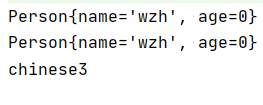这篇文章给大家介绍this与super怎么在Java中使用,内容非常详细,感兴趣的小伙伴们可以参考借鉴,希望对大家能有所帮助。
一、this
概念:this代表着当前对象的引用,也是当前函数所属对象的引用。直白的说,哪个对象调用了当前函数,this就代表哪个对象。
常见的用法(理论不理解就先参考下面案例)
最常见的情况是是对象的一个属性或被构造器的参数屏蔽时,如果需要调用屏蔽的属性,this就代表哪个对象
this只能在方法内使用,表示正在调用方法的那个对象,但是,如果在方法内调用同一个类的另一个方法,就不必使用this,直接调用即可,this关键字是能省则省
this和static的关系:
static方法是类方法,依附于类而不依赖与任何对象,static属性是指该属性是类中所有对象所共享的,static方法是类方法,先于任何实例(对象)存在,static在类加载时就已经存在了,但对象是在创建时才生成;方法中使用this关键字它的值是当前对象的引用,只能用它调用属于当前对象的属性和方法和。但是,this可以调用static类型的属性,举个例子:一个父亲是不可能向他还未出生的孩子借钱的,但孩子出生后完全可以找他父亲去借钱;
对于一个类中的this,不一定单指这个的对象,也可能是这个类的子类的对象(抽象类里面的this只能是实际调用中它的派生类的实例化对象);
总之:如果new 父类对象的话,父类方法的this指向的是父类,如果new 子类,那么父类方法的this指向的是子类
this关键字也可以用于在构造函数中调用其他构造函数。但是,只能定义在构造函数的第一行,因为初始化动作要先执行
this使用案例
class Student extends Person{
public Student(String name, int age, String nation) {
super(name);
}
}
public class Person{
private String name;
private int age;
private static String nation = "chinese";
public Person(String name) {
this.name = name;
}
public Person(String name, int age) {
//初始化方法必须放到第一行
this(name);
this.age = age;
}
//局部变量name和age屏蔽了name和age属性,用this进行标识
public Person(String name, int age,String nation) {
this.name = name;
this.age = age;
//this可以调用到静态属性
this.nation = nation;
}
public void test(){
System.out.println("测试");
}
public static void test2(){
//静态方法内不能出现this或super
System.out.println("测试");
}
public void print(){
//调用类内部的方法(toString已重写)加不加this都行
this.toString();
}
@Override
public String toString() {
return "Person{" +
"name='" + name + '\'' +
", age=" + age +
'}';
}
public static void main(String[] args) {
//这个this代表的student对象
Student student = new Student("wzh",20,"chinese2");
System.out.println(student.toString());
//这个this代表的是person对象
Person person = new Person("wzh3",20,"chinese3");
System.out.println(student.toString());
//扩展,全局变量nation的值最后是chinese3
System.out.println(Person.nation);
}
}结果:

概念:
super可以理解为“父类的”,super可以在子类中调用父类的属性,方法,构造器,super关键字和this一样能省就省;
注意点:
1、this和super很像,this指向的是当前对象的调用,super指向的是当前调用对象的父类
2、类加载完毕,创建对象,父类的构造方法会被调用
父类如果重写了无参构造器或者父类中没有有参构造器,那么子类的构造方法第一行就是super(),可以省略
class Student extends Person{
//这是默认的构造器内容,写出来是为了帮大家理解
public Student(){
super();
}
}
public class Person{
private String name;
private int age;
}如果父类中定义了有参构造器但没有显示写出无参构造器,那么必须通过super调用父类的有参构造函数,如果父类中定义了多个有参构造区,那么用super调用其中一个有参构造器即可
class Student extends Person{
public Student(String name, int age) {
//任选一个父类有参构造
//super(name, age);
super(name);
}
}
public class Person{
private String name;
private int age;
public Person(String name, int age) {
this.name = name;
this.age = age;
}
public Person(String name) {
this.name = name;
}
}3、子类相应构造创建了一个子类对象,该子类对象还包含了一个父类对象。该父类对象在子类对象内部(正如子类的构造器无论如何都要通过super调用父类构造器一样,子类的对象被成功构造,那么它的内部就会包含父类的对象),证明如下
子类重写父类的方法后可以通过super调用到父类的方法
class Student extends Person {
private String name = "wzh3";
@Override
public String getName() {
return "子类" + name;
}
public String getParentName(){
//调用父类的方法
return super.getName();
}
public static void main(String[] args) {
Student student = new Student();
System.out.println(student.getName());
System.out.println(student.getParentName());
}
}
public class Person{
//protected意味着子类和同一包中可以访问
protected String name = "wzh";
protected int age = 20;
public String getName() {
return "父类" +name;
}
}输出结果

子类获取到父类的变量
class Student extends Person{
public void parentDisplay(){
System.out.println(super.age + super.name);
}
public static void main(String[] args) {
new Student().parentDisplay(); //输出结果:20wzh
}
}
public class Person{
//protected意味着子类和同一包中可以访问
protected String name = "wzh";
protected int age = 20;
}调用父类的构造器
不再举例
4、this super只能在有对象的前提下使用,不能在静态上下文使用
5、如果一个类没有基础任何父类,super还有用吗?肯定有用,可以调用Object中的方法
public class Person{
private String name;
private int age;
public void display(){
//通过this或super调用到了Object的toString();
System.out.println(super.toString());
}
public static void main(String[] args) {
new Person().display(); //输出为Person@452b3a41
}
}关于this与super怎么在Java中使用就分享到这里了,希望以上内容可以对大家有一定的帮助,可以学到更多知识。如果觉得文章不错,可以把它分享出去让更多的人看到。
免责声明:本站发布的内容(图片、视频和文字)以原创、转载和分享为主,文章观点不代表本网站立场,如果涉及侵权请联系站长邮箱:is@yisu.com进行举报,并提供相关证据,一经查实,将立刻删除涉嫌侵权内容。